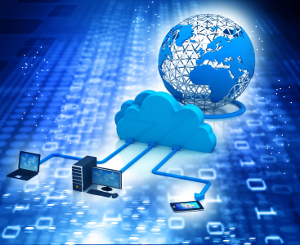Cloud computing and Software as a Service (SaaS) are two trends that continue to gain momentum and promise to positively impact the electrical industry. While there is some conjecture about who first came up with the term “cloud computing”, what we do know is that it first started to appear in the mid 1990’s and has been gaining steam since then.
So what is cloud computing?
The term “cloud computing” in simple terms means storing and accessing data and programs over the internet instead of your computer’s hard drive. It goes back to the days of flowcharts and presentations that would represent the gigantic server-farm infrastructure of the internet as nothing but a puffy, white cumulus cloud.
What cloud computing is not about is your hard drive. When you store data or run programs from your PC’s hard drive, that’s called local storage and computing. Everything you need is physically close to you, which means accessing your data is fast and easy, for that one computer, or others on the local network. Working off your hard drive is how the computer industry functioned for decades.
The cloud is also not about having dedicated servers or storage devices networked within your business or residence. Storing data on a home or office network does not count as using the cloud. For it to be considered cloud computing you need to access your data and programs over the internet.
Historically, the cost to implement fast networks was a key limiting factor in moving to cloud computing. We have observed significant advancements in communications technology in recent years, with networking speeds increasing significantly and the proliferation of wireless and mobile data networks giving rise to a new level of flexibility in the way we access programs and data.
What does this mean for business? In particular, we will focus on the emergence of SaaS - which means running your application software in the cloud and subscribing to it like you would for a service. The question is why would a business use the SaaS model over the traditional approach of buying, building and maintaining IT infrastructure and software on-site?
SaaS gives companies an alternative. Now, they can connect and subscribe to services built on shared infrastructure via the internet. The uptake of the SaaS model has grown significantly in recent years because of the many benefits it offers to businesses of all sizes and types. Here are some of the key advantages driving industry to implement SaaS solutions:
Lower up-front investment
With SaaS applications, customers avoid the large initial investment in IT infrastructure and the day-to-day responsibility of maintaining that infrastructure. SaaS applications are typically subscription based, without up-front license fees that results in lower initial costs. Having the SaaS provider manage the IT infrastructure means lower IT costs for hardware, software, and the people needed to manage it all.
Ease of deployment and platform independent
Most modern SaaS applications are accessed by the user through a standard web browser. This means that there is little or no requirement to deploy application software on the user PCs across the organisation. Given the use of web browser technology, SaaS applications can be accessed from a range of devices including PCs, tablets and mobile phones.
Scalability
As SaaS applications are subscription based, you only pay for what you need. You can start with a limited subscription and expand or reduce the subscription to suit your needs over time.
Accessibility
SaaS applications are available from any computer or any device any-time, anywhere. Most people are familiar with using the internet to find what they need, resulting in SaaS apps tending to have high adoption rates, with a lower learning curve.
Painless upgrades and minimal maintenance headaches
The SaaS provider manages the updates and upgrades, leaving no patches for customers to download or install. The SaaS provider also manages availability, so there’s minimal need for customers to add hardware, software, or bandwidth as the user base grows.
Disaster Recovery
Like local IT installations, SaaS vendors must also consider the occurrence of a disaster and how to recover from it. Continuity of business is the key concept, which most SaaS vendors will plan with you to address. A Recovery Time Objective may be negotiable, utilising advanced cloud features such as geo replication and resiliency. The SaaS vendor should be able to offer services to generate backups with a frequency that makes sense for the business process to achieve the desired Recovery Point Objective. All this can occur as part of the SaaS service, unloading the requirement for your own people to execute. What about the electrical industry?
One of the key differences between the IT industry and the electrical industry is the large array of different field devices that need to be connected - the so called “Internet of Things” or IoT. Whilst the IT industry largely connects PCs and servers together, the electrical industry works with devices such as energy meters, variable speed drives, sensors and actuators, PLCs and circuit breakers, to name a few.
With communications enabled devices becoming commonplace, combined with readily available wireless and mobile data networks, the task of connecting field equipment to the cloud in a cost effective manner has become a reality.
Combine this with application software running in the cloud and we are now at a point where real-time monitoring of electrical assets, not only within the four walls of a single site, but across multiple sites, multiple regions and countries is achievable.
Whilst modern SaaS systems are secure and robust, and disaster recovery options can accommodate many cases, there will still be some trepidation in moving some software to a cloud service. SaaS makes perfect sense for some business processes, others perhaps not. But where it does make sense, NHP is committed to leveraging these new technologies and providing innovative products and solutions that help our customers and their operations!
Richard Harrison
Chief Technology Officer, NHP
